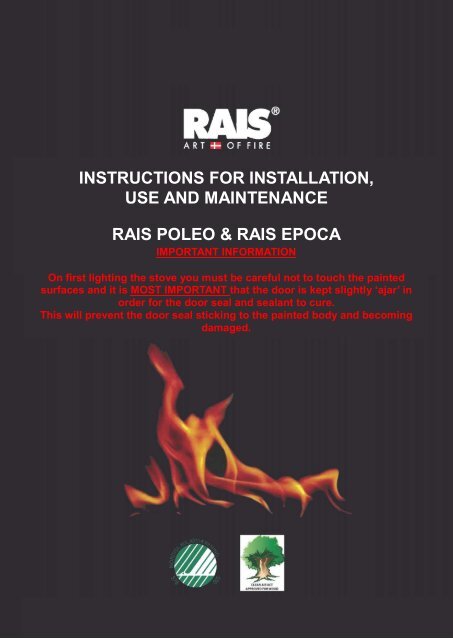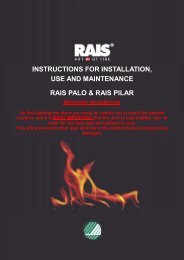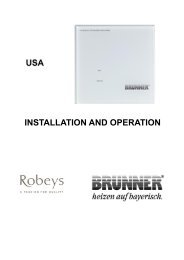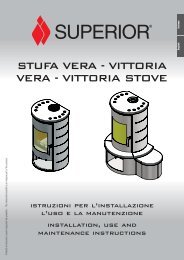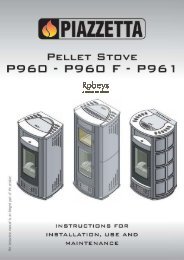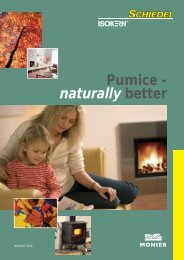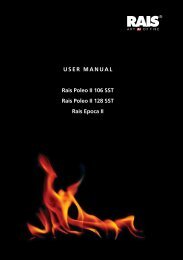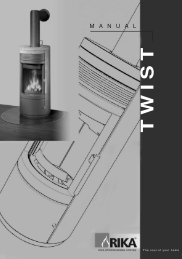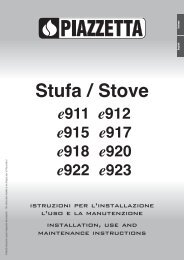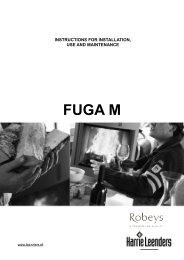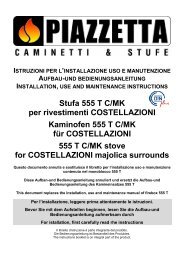instructions for installation, use and maintenance rais ... - Robeys Ltd
instructions for installation, use and maintenance rais ... - Robeys Ltd
instructions for installation, use and maintenance rais ... - Robeys Ltd
Create successful ePaper yourself
Turn your PDF publications into a flip-book with our unique Google optimized e-Paper software.
ENGLISHRAIS manual <strong>for</strong> Rais Poleo <strong>and</strong> Rais EpocaINSTRUCTIONS FOR INSTALLATION,USE AND MAINTENANCERAIS POLEO & RAIS EPOCAIMPORTANT INFORMATIONOn first lighting the stove you must be careful not to touch the paintedsurfaces <strong>and</strong> it is MOST IMPORTANT that the door is kept slightly ‘ajar’ inorder <strong>for</strong> the door seal <strong>and</strong> sealant to cure.This will prevent the door seal sticking to the painted body <strong>and</strong> becomingdamaged.1
ENGLISHRAIS manual <strong>for</strong> Rais Poleo <strong>and</strong> Rais Epoca2
ENGLISHRAIS manual <strong>for</strong> Rais Poleo <strong>and</strong> Rais EpocaRAIS POLEO95 RAIS POLEO 106RAIS EPOCARevisionDate : 2011INTRODUCTION ………………………………………………………….. 4WARRANTY …………………………………………………….………….. 4SPECIFICATIONS ………………………………………………………….. 5INSTALLATION INSTRUCTIONS ………………………………….……… 6CONVECTION …………………………………………………………. 7CHIMNEY …………………………………………………….…………. 78HEARTH …………………………………………………………………. 8INSTALLATION ………………………………………………………... 9OPERATION OF SWIVEL BASE …………...……………………….. 10ADJUSTMENT OF CHIMNEY CONNECTION ……………………… 1112QUICK GUIDE …………………………………………………………. 13INSTALLATION DISTANCE TO COMBUSTIBLE WALL ……….… 14GENERAL INSTALLATION (RIGHT ANGLE) SECURE BASE ….. 15CORNER INSTALLATION 45° ………………………………………. 16360° SWIVEL BASE …………………………………………………… 17INSTALLATION DISTANCE TO NONCOMBUSTIBLE WALL ….. 18FOR THE INSTALLER ……………………………………………….... 19OPERATING INSTRUCTIONS …………………………………………….. 20FUEL ……………………………………………………………………... 20DRYING AND STORAGE ……………………………………………… 21ADJUSTING THE AIR DAMPER ……………………………………. 22CONTROL ……………………………………………………………….. 22FIRST USAGE ………………………………………………………….. 23LIGHTING AND FUELLING …………………………………………… 2425MAINTENANCECLEANING AND CARE ……………………………………………….. 26CLEANING OF THE FLUE WAYS …………………………………… 27PROBLEM SOLVING ………………………………………………….. 28ACCESSORIES AND SPARE PARTS ……………………………………. 29SPARE PART DIAGRAM POLEO 95 AND POLEO 106 .…………. 3031SPARE PART DIAGRAM EPOCA …….……………………………… 32333
ENGLISHRAIS manual <strong>for</strong> Rais Poleo <strong>and</strong> Rais EpocaINTRODUCTIONThank you <strong>for</strong> purchasing a Rais wood burning stove.These appliances have been approved by HETAS asintermittent operating appliances <strong>for</strong> burning wood logs only.These appliances have been approved <strong>for</strong> <strong>use</strong> in Smokeless Zones.A Rais wood burning stove is more than just a heat source: it also shows that youcare about design <strong>and</strong> quality in your home.To make the most of your wood burning stove it is important that you read the manualthoroughly be<strong>for</strong>e installing <strong>and</strong> using it.In the case of warranty coverage, <strong>and</strong> <strong>for</strong> general queries regarding your woodburning stove, it is important that you know the stove’s production number.We there<strong>for</strong>e recommend that you note down the number in the table below.The production number is located at the back of the stove at the bottom.WARRANTYYour Rais wood burning stove comes with a 5 year warranty.The warranty, however, does not cover heatinsulating materials, glass <strong>and</strong> seals.These are available to order from your local Rais dealer / stockist.Any alterations made to the stove will void the warranty.4
ENGLISHRAIS manual <strong>for</strong> Rais Poleo <strong>and</strong> Rais EpocaSPECIFICATIONSRais Poleo 95 Rais Poleo 106Rais EpocaNominal output (kW): 4.5 4.54.5Min. / Max. output (kW): 2 7 2 72 7Heating area (m 2 ): Approx. 80 Approx. 80Approx. 80Size, width/depth/height (mm): 574 448 950 574 448 1058510 408 1056Combustion chamber width/depth/height (mm). 360 240 380 360 240 380360 240 380Recommended amount of wood when fuelling (kg)1.6 1.61.6(Based on 2 3 logs of wood approx. 25cm)Min. uptake / Min. draught (Pascal): 12 1212Weight (kg): 131 137123Efficiency (%): 76 76 76Particles after NS3058/3059 (g/kg): 2.5 2.5 2.5Dust measured according to Din+ (mg/Nm 3 ):Smoke gas mass flow (g/s): 6.4 6.46.4Smoke gas temperature (°C): 250 250250Intermittent operation: Fuelling should be undertakenwithin 3 hours5
ENGLISHRAIS manual <strong>for</strong> Rais Poleo <strong>and</strong> Rais EpocaINSTALLATION INSTRUCTIONSThe following pages give <strong>instructions</strong> <strong>for</strong> the safe <strong>and</strong> proper <strong>installation</strong> of this heatingappliance in the UK. These <strong>instructions</strong> cover the basic principles of <strong>installation</strong>,although some details may need slight modification to suit particular local site conditions.In all cases the <strong>installation</strong> must comply with current UK Building Regulations, LocalAuthority Byelaws <strong>and</strong> other specifications or regulations as they affect the <strong>installation</strong> ofthe stove.Please note that it is a legal requirement under Engl<strong>and</strong> <strong>and</strong> Wales Building Regulationsthat the <strong>installation</strong> of the stove is either carried out under local Authority BuildingControl approval or is installed by a Competent Person registered with a Governmentapproved Competent Persons Scheme. HETAS operate such a scheme <strong>and</strong> a listing oftheir registered Competent Persons can be found on their website at www.hetas.co.uk.It should be noted that the current Building Regulations requirements are given inApproved Document J. These requirements may also be met by adopting the relevantrecommendations given in British St<strong>and</strong>ards BS 8303, BS 6461 <strong>and</strong> BS 7566.WARNING. Health <strong>and</strong> Safety Advice Notice.The <strong>installation</strong> of this heating appliance is governed by the Health <strong>and</strong> Safety at WorkAct 1974. it is the responsibility of the installer to ensure that all requirements of this Actare met during the <strong>installation</strong> works. Attention is drawn in particular to the following:H<strong>and</strong>ling:The appliance is a heavy item <strong>and</strong> adequate facilities must be available<strong>for</strong> loading, unloading <strong>and</strong> site h<strong>and</strong>ling.Fire Cement: Some types of fire cement are caustic <strong>and</strong> should not be allowed to comeinto contact with the skin. Protective gloves should be worn whenh<strong>and</strong>ling fire cement. In case of contact with the skin, wash immediatelywith plenty of water.Asbestos:Metal Parts:This stove contains no asbestos. If there is a possibility of disturbing anyasbestos in the course of the <strong>installation</strong>, then please seek specialistguidance <strong>and</strong> <strong>use</strong> appropriate protective equipment.When installing or servicing this stove care should be taken to avoid thepossibility of personal injury.Important Warning Preparatory Work <strong>and</strong> safety Checks:· This stove must not be installed into a chimney which serves any other heatingappliance.· There must not be an extractor fan fitted in the same room as the stove, as this canca<strong>use</strong> the stove to emit fumes into the room.· If this appliance is installed into an existing chimney, the chimney must first beswept <strong>and</strong> examined <strong>for</strong> soundness <strong>and</strong> suitability, be<strong>for</strong>e the appliance is installed(see also section headed ‘Chimney’).6
ENGLISHRAIS manual <strong>for</strong> Rais Poleo <strong>and</strong> Rais EpocaConvectionRais stoves are convection stoves. This means that the stove’s back <strong>and</strong> side panels arenot overheated. Convection means that there is a circulation of air, which ensures thatthe heat is distributed more evenly throughout the entire room. The cold air is sucked in atthe base of the stove <strong>and</strong> up through the convection channel, which runs along thestove’s combustion chamber. The heated air comes out at the top of the stove, whichensures a circulation of warm air throughout the room.The stoves are equipped with cool door h<strong>and</strong>les a Rais special feature which meansyou could almost do away with gloves. Be aware, however, that all exterior surfacesbecome hot during <strong>use</strong> so take extreme care.ChimneyIn order <strong>for</strong> the stove to per<strong>for</strong>m satisfactorily the chimney height must be sufficient toensure an adequate draught of approximately 15 Pa so as to clear the products ofcombustion <strong>and</strong> prevent smoke problems into the room.NOTE: A chimney height of not less than 4.5 metres measured vertically from the outlet ofthe stove to the top of the chimney should be satisfactory. Alternatively the calculationprocedure given in EN 133841 may be <strong>use</strong>d as the basis <strong>for</strong> deciding whether aparticular chimney design will provide sufficient draught.The outlet from the chimney should be above the roof of the building in accordance withthe provisions of Building Regulations Approved Document J.If <strong>installation</strong> is into an existing chimney then it must be sound <strong>and</strong> have no cracks orother faults which might allow fumes into the ho<strong>use</strong>. Older properties, especially, mayhave chimney faults or the cross section may be too large i.e. more than 230 mm x 230mm. Remedial action should be taken, if required, seeking expert advice, if necessary. If itis found necessary to line the chimney then a flue liner suitable <strong>for</strong> solid fuel must be <strong>use</strong>din accordance with Building Regulations Approved Document J.Any existing chimney must be clear of obstruction <strong>and</strong> have been swept cleanimmediately be<strong>for</strong>e <strong>installation</strong> of the stove. If the stove is fitted in place of an open firethen the chimney should be swept one month after <strong>installation</strong> to clear any soot fallswhich may have occurred due to the difference in combustion between the stove <strong>and</strong> theopen fire.If there is no existing chimney then any new system must be to the designationdescribed above <strong>and</strong> in accordance with Building Regulations Approved Document J.A single wall metal fluepipe is suitable <strong>for</strong> connecting the stove to the chimney but is notsuitable <strong>for</strong> <strong>use</strong> as the complete chimney. The chimney <strong>and</strong> connecting fluepipe musthave a minimum diameter of 150 mm <strong>and</strong> its dimension should be not less than the sizeof the outlet socket of the stove.7
ENGLISHRAIS manual <strong>for</strong> Rais Poleo <strong>and</strong> Rais EpocaAny bend in the chimney or connecting fluepipe should not exceed 45°.90° bends should not be <strong>use</strong>d.Combustible material should not be located where the heat dissipating through thewalls of fireplaces or flues could ignite it. There<strong>for</strong>e when installing the stove in thepresence of combustible materials due account must be taken of the guidance on theseparation of combustible material given in Building Regulations Approved DocumentJ <strong>and</strong> also in these stove <strong>instructions</strong>.If it is found that there is excessive draught in the chimney then a draught stabilisershould be fitted. Fitting of a draught stabiliser will affect the requirement <strong>for</strong> thepermanent air supply into the room in which the stove is fitted in accordance withApproved Document J (see also combustion air supply).Adequate provision e.g. easily accessible soot door or doors must be provided <strong>for</strong>sweeping the chimney <strong>and</strong> connecting fluepipe where it is not intended <strong>for</strong> thechimney to be swept through the appliance.Chimney FiresIf the chimney is thoroughly <strong>and</strong> regularly swept, chimney fires should not occur.However, if a chimney fire does occur turn off the stove immediately <strong>and</strong> isolate themains electricity supply (if applicable), <strong>and</strong> tightly close the doors of the stove. Thisshould ca<strong>use</strong> the chimney fire to go out. If the chimney fire does not go out when theabove action is taken then the fire brigade should be called immediately. Do not relightthe stove until the chimney <strong>and</strong> flue ways have been cleaned <strong>and</strong> examined by aprofessional.HearthThe hearth should be able to accommodate the weight of the stove <strong>and</strong> its chimney ifthe chimney is not independently supported. The weight of the stove is indicated in thebrochure.The stove should preferably be installed on a noncombustible hearth of a size <strong>and</strong>construction that is in accordance with the provisions of the current Building RegulationsApproved Document J.The clearance distances to combustible material beneath, surrounding or upon thehearth <strong>and</strong> walls adjacent to the hearth should comply with the guidance on theseparation of combustible material given in Building Regulations Approved DocumentJ <strong>and</strong> also in these stove <strong>instructions</strong>.If the stove is to be installed on a combustible floor surface, it must be covered with anoncombustible material at least 12mm thick, in accordance with Building RegulationsApproved Document J, to a distance of 30 cm in front of the stove <strong>and</strong> 15 cm to eachside measuring from the door of the combustion chamber.8
ENGLISHRAIS manual <strong>for</strong> Rais Poleo <strong>and</strong> Rais EpocaCombustion air supplyIn order <strong>for</strong> the stove to per<strong>for</strong>m efficiently <strong>and</strong> safely there must be an adequate airsupply into the room in which the stove is installed to provide combustion air. Theprovision of air supply to the stove must be in accordance with current BuildingRegulations Approved Document J. An opening window is not appropriate <strong>for</strong> thispurpose.InstallationIt is prohibited to carry out unauthorised alterations to the stove.There must be plenty of fresh air in the room where the stove is being installed, in order toensure proper combustion. Note that any mechanical exhaust ventilation e.g. anextraction hood may reduce the air supply. Any air grilles must be placed in such amanner, that the air supply is not blocked.The stove is equipped with four convection air outlets, which may be connected withsuitable air ducts to other rooms.Building Regulations Approved Document J gives specific guidance on the requiredpermanent ventilation into the room <strong>for</strong> combustion air of solid fuel appliances.The floor structure must be able to carry the weight of the wood burning stove, as well asthe weight of a chimney, if necessary.When you choose where to set up your RAIS wood burning stove, you should consider theheat distribution to the other rooms. This will enable you to get the best <strong>use</strong> out of yourstove.The stove should be set up at a safe distance from inflammable materials.See the manufacturer's plate on the wood burning stove.Installation of stove:NOTE !A decision must be made concerning the positioning of the inlets <strong>and</strong> outlets ofthe convection system. Discolouration of the wall above the doors <strong>and</strong> theconvection air outlets may occur due to convected hot air.RAIS cannot take responsibility <strong>for</strong> any building work or consequential damage.The stove should be inspected <strong>for</strong> defects at receipt.9
ENGLISHRAIS manual <strong>for</strong> Rais Poleo <strong>and</strong> Rais EpocaOperation of revolving baseIf the stove has a revolving base then please do the following:Push / pull the pedal / release arm, after which the stove can be turned at 30° intervals.When the stove is in the desired position, let go of the pedal <strong>and</strong> turn the stove lightly untilthe pedal falls into place.10
ENGLISHRAIS manual <strong>for</strong> Rais Poleo <strong>and</strong> Rais EpocaAdjustment of the chimney connectionThe stove is always delivered <strong>for</strong> top flue connection, but can be changed to rear flueconnection as follows:Remove the baffle plate<strong>and</strong> smoke diverter ( seecleaning <strong>and</strong> care ).Loosen the three M6 nuts with a spanner.Poleo:Lift the reflector plate up <strong>and</strong> remove the knock outplate. Replace the reflector plate.Epoca:Lift one of the two part reflector plates up <strong>and</strong> breakoff the knock out plate, replace the reflector plate.Repeat on the other part of the reflector plate11
ENGLISHRAIS manual <strong>for</strong> Rais Poleo <strong>and</strong> Rais EpocaRemove the casing knockout.Remove the protective cover / seal <strong>and</strong> place over thehole in the top make sure that the seal is positionedproperly. Tighten the assembly using the three M6 nuts.The flue outlet spigot, which can be found in the stove in abag, <strong>and</strong> the holder <strong>for</strong> the upper flue diverter areassembled with 3 M6 x 20 nuts <strong>and</strong> bolts.The upper flue diverter, baffle plate <strong>and</strong> top plate areassembled in reverse order.12
ENGLISHRAIS manual <strong>for</strong> Rais Poleo <strong>and</strong> Rais Epoca13
ENGLISHRAIS manual <strong>for</strong> Rais Poleo <strong>and</strong> Rais EpocaInstallation distance to combustible wallTo find out whether the wall next to where the stove is going to be installed is flammable,you should contact your building contractor or the local building authorities.The hearth should be able to accommodate the weight of the stove. The chimney mustbe independently supported by wall brackets or a ceiling support plate. The weight of thestove is indicated in the brochure.The stove should always be installed on a noncombustible hearth of a size <strong>and</strong>construction that is in accordance with the provisions of the current UK BuildingRegulations Approved Document J.If the stove is to be installed on a wooden floor, it must be covered with anoncombustible material at least 12mm thick, in accordance with UK BuildingRegulations Approved Document J, to a distance of 300 mm in front of the stove <strong>and</strong>150 mm to each side measuring from the door of the combustion chamber.The clearance distances to combustible material beneath, surrounding or upon thehearth <strong>and</strong> walls adjacent to the hearth should comply with the guidance on theseparation of combustible material given in UK Building Regulations ApprovedDocument J <strong>and</strong> also in these stove <strong>instructions</strong>.Commissioning <strong>and</strong> h<strong>and</strong>overEnsure all parts are fitted in accordance with the <strong>instructions</strong>.On completion of the <strong>installation</strong> allow a suitable period of time <strong>for</strong> any fire cement <strong>and</strong>mortar to dry out, be<strong>for</strong>e lighting the stove. Once the stove is under fire check all seals<strong>for</strong> soundness <strong>and</strong> check that the flue is functioning correctly <strong>and</strong> that all products ofcombustion are vented safely to atmosphere via the chimney terminal.On completion of the <strong>installation</strong> <strong>and</strong> commissioning ensure that the operating<strong>instructions</strong> <strong>for</strong> the stove are left with the customer. Ensure to advise the customer onthe correct <strong>use</strong> of the appliance <strong>and</strong> warn them to <strong>use</strong> only the recommended fuel <strong>for</strong> thestove.Advise the <strong>use</strong>r what to do should smoke or fumes be emitted from the stove. Thecustomer should be warned to <strong>use</strong> a fireguard to BS 8423:2002 (Replaces BS 6539) inthe presence of children, aged <strong>and</strong>/or infirm persons.CO AlarmBuilding regulations require that when ever a new or replacement fixed solid fuel orwood/biomass appliance is installed in a dwelling a carbon monoxide alarm must befitted in the same room as the appliance. Further guidance on the <strong>installation</strong> of thecarbon monoxide alarm is available in BS EN 50292:2002 <strong>and</strong> from the alarmmanufacturer’s <strong>instructions</strong>.Provision of an alarm must not be considered a substitute <strong>for</strong> either installing theappliance correctly or ensuring regular servicing <strong>and</strong> <strong>maintenance</strong> of the appliance <strong>and</strong>chimney system.14
ENGLISHRAIS manual <strong>for</strong> Rais Poleo <strong>and</strong> Rais Epoca15
ENGLISHRAIS manual <strong>for</strong> Rais Poleo <strong>and</strong> Rais Epoca16
ENGLISHRAIS manual <strong>for</strong> Rais Poleo <strong>and</strong> Rais EpocaUsing uninsulated flue pipe, the minimum distance to a combustible wall must be 450mmor 225mm if the wall is heatshielded ( see Section J of the Building Regulations ) fromthe flue pipe.17
ENGLISHRAIS manual <strong>for</strong> Rais Poleo <strong>and</strong> Rais EpocaInstallation distance to noncombustible wallWe recommend a minimum distance to noncombustible material of 50mm ( F ) <strong>for</strong>cleaning considerations.It should always be possible to access the soot door18
ENGLISHRAIS manual <strong>for</strong> Rais Poleo <strong>and</strong> Rais EpocaFor the InstallerFinally be<strong>for</strong>e firing the stove <strong>for</strong> the first time a check should be made to ensure that theassembly <strong>and</strong> stove <strong>installation</strong> has been satisfactory <strong>and</strong> that there are no leaks in anyseals in the appliance <strong>and</strong> appliance connections to the chimney.Ensure that the appliance <strong>and</strong> chimney flue are functioning correctly be<strong>for</strong>e finallyh<strong>and</strong>ing over to the <strong>use</strong>r. Read the later parts of this manual <strong>for</strong> guidance on carerequired when first lighting.In<strong>for</strong>m the <strong>use</strong>r that the appliance has been commissioned <strong>and</strong> ready to <strong>use</strong> <strong>and</strong> giveinstruction on the safe operation of the stove.These Instructions must be left with the <strong>use</strong>r <strong>and</strong> the <strong>use</strong>r should be instructed to keepthem in a safe place.19
ENGLISHRAIS manual <strong>for</strong> Rais Poleo <strong>and</strong> Rais EpocaOPERATING INSTRUCTIONSPlease note that HETAS Appliance Approval only covers the <strong>use</strong> of dry seasoned woodlogs on this appliance. HETAS Approval does not cover the <strong>use</strong> of other fuels eitheralone or mixed with the wood logs, nor does it cover <strong>instructions</strong> <strong>for</strong> the <strong>use</strong> of otherfuels.FuelThe stove is designed <strong>and</strong> approved in accordance with EN 13240 <strong>and</strong> NS 3058 <strong>for</strong>stoking split, dried firewood. The firewood must have a water content of 1522% <strong>and</strong> itsmax. length should be the length of the combustion chamber minus 5060 mm.Stoking with wet firewood ca<strong>use</strong>s both soot, environmental pollution <strong>and</strong> bad fueleconomy. Freshly cut wood contains approx. 5070% water <strong>and</strong> is thoroughly unsuitable<strong>for</strong> stoking. Allow at least 1 year of storage time <strong>for</strong> newly cut wood be<strong>for</strong>e using. Woodwith a diameter of more than 100 mm should be split. Regardless of wood size, it shouldalways have at least one surface area free of bark.We do not recommend stoking with painted, laminated or impregnated wood, wood witha synthetic surface, painted ref<strong>use</strong> wood, chipboard, plywood, domestic waste, paperbriquettes <strong>and</strong> pit coal, as this will produce malodorous smoke, which could bepoisonous.When firing with the abovementioned items <strong>and</strong> amounts larger than thoserecommended, the stove is subjected to a larger amount of heat, which results in ahigher chimney temperature <strong>and</strong> lower efficiency. This can result in the stove <strong>and</strong>chimney becoming damaged <strong>and</strong> would void the warranty.The calorific value of the firewood is closely connected to the moisture level.Moist firewood has a low heat value. The more water the wood contains, the moreenergy it takes <strong>for</strong> this water to vaporise, resulting in this energy being lost.ONLY USE RECOMMENDED FUELSThe following table shows the calorific value of different types of wood, which have beenstored <strong>for</strong> 2 years <strong>and</strong> which have a residual moisture of 15 17%.Wood Kg dry wood pr m 3 compared to beech/oakHornbeam 640 110%Beech <strong>and</strong> oak 580 100%Ash 570 98%Maple 540 93%Birch 510 88%Mountain pine 480 83%Fir 390 67%Poplar 380 65%1kg of wood yields the same heat energy irrespective of wood type.1kg of beech merely takes up less space than 1kg of fir.20
ENGLISHRAIS manual <strong>for</strong> Rais Poleo <strong>and</strong> Rais EpocaDrying <strong>and</strong> storageDrying wood takes time: proper air drying takes approximately 2 years.Here are some tips:Store the wood sawn, split <strong>and</strong> stacked in an airy, sunny place, which is protectedagainst rain (the south side of the ho<strong>use</strong> is particularly suitable).Store the firewood stacks at a h<strong>and</strong>'s breadth apart, as this ensures that the air flowingthrough takes the moisture with it. Avoid covering the firewood stacks with plastic, as thisprevents the moisture from escaping. It is a good idea to bring the firewood into theho<strong>use</strong> 23 days be<strong>for</strong>e you need it.Regulating the combustion airAll RAIS stoves are equipped with a oneh<strong>and</strong>ed operating lever <strong>for</strong> regulating thedamper. The stovespecific regulating mechanisms can be seen on the diagrams.Primary air is the combustion air added to the primary combustion zone, i.e. the bed ofglowing embers. This air, which is cold, is only <strong>use</strong>d in the lighting stage. Secondary airis the air which is added in the gas combustion zone, i.e. air which contributes to thecombustion of the pyrolysis gasses (preheated air, which is <strong>use</strong>d <strong>for</strong> the cleaner glasssystem <strong>and</strong> combustion). This air is sucked through the damper under the combustionchamber <strong>and</strong> is preheated through the side channels <strong>and</strong> then emitted as hot scavengingair onto the glass. The hot air rinses the glass <strong>and</strong> keeps it sootfree.The tertiary channel, which can be seen at the top of the combustion chamber towardsthe back, serves to combust the final gas residues.By setting the interval between position 1 <strong>and</strong> 2, the energy content in the firewood is<strong>use</strong>d optimally, as there is oxygen <strong>for</strong> combustion <strong>and</strong> <strong>for</strong> the burning of the pyrolysisgasses. When the flames are a clear yellow the damper has been set correctly. Findingthe correct position comes with time after you have <strong>use</strong>d <strong>for</strong> stove <strong>for</strong> a while.It is not recommended that you turn it down completely. A mistake commonly made isshutting the damper too early beca<strong>use</strong> it feels too hot. This results in dark smoke emanatingfrom the chimney <strong>and</strong> in the calorific value of the firewood not being <strong>use</strong>d to itsfullest.Room ventilation <strong>and</strong> stovesThere must not be an extractor fan fitted in the same room as the stove as this canca<strong>use</strong> the stove to emit smoke <strong>and</strong> fumes into the room.The stove requires a permanent <strong>and</strong> adequate air supply in order <strong>for</strong> it to operate safely<strong>and</strong> efficiently.In accordance with current Building Regulations the installer may have fitted a permanentair supply vent into the room in which the stove is installed to provide combustionair. This air vent should not under any circumstances be shut off or sealed.21
ENGLISHRAIS manual <strong>for</strong> Rais Poleo <strong>and</strong> Rais EpocaAdjusting the air damper.The damper has 3 settings.Position 1The damper is almost closed meaning that there is aminimal air intake.Position 2Push the lever to the right until it stops. This positiongives full secondary air.During normal <strong>use</strong> the lever is set between position1 <strong>and</strong> 2.When the flames are clear <strong>and</strong> yellow, the damper isset correctly, i.e. resulting in a slow/optimal burning.Position 3Push the lever upwards <strong>and</strong> to the right.The air damper is completely open <strong>and</strong> gives fullprimary <strong>and</strong> secondary air. This position is <strong>for</strong> thelighting stage <strong>and</strong> is not <strong>use</strong>d under normal operation.ControlIf the ash is white <strong>and</strong> the walls in the combustion chamber are soot free after the stovehas been <strong>use</strong>d, the air regulation was set correctly <strong>and</strong> the wood was sufficiently dry.22
ENGLISHRAIS manual <strong>for</strong> Rais Poleo <strong>and</strong> Rais EpocaFirst usageA careful start pays off. Start with a small fire, so that the wood burning stove can getaccustomed to the high temperature. This gives the best start <strong>and</strong> any damage isavoided.Be aware that a strange but harmless odour <strong>and</strong> smoke concoction may emanate fromthe surface of the stove, the first time you fire up. This is beca<strong>use</strong> the paint <strong>and</strong>materials need to harden. The odour disappears quickly, but you should check theventilation <strong>and</strong> draught, if possible. See also, the IMPORTANT warning notice belowabout persistent fumes.During this process you must be careful not to touch the painted surfaces, <strong>and</strong> it isrecommended that you regularly open <strong>and</strong> close the door to prevent the door seal fromsticking.The stove may also produce "clicking noises" during heating <strong>and</strong> cooling, ca<strong>use</strong>d by thelarge temperature differences which the material is subjected to.Never <strong>use</strong> any type of liquid fuel <strong>for</strong> kindling or maintaining the fire. You could be at riskof explosion.The stove gets very hot when in <strong>use</strong>, always wear protective gloves when tending thestove.If the stove has not been <strong>use</strong>d <strong>for</strong> a while, follow the steps as if you were using it <strong>for</strong> thefirst time.IMPORTANT Warning Note!Properly installed, operated <strong>and</strong> maintained this appliance will not emit fumes into thedwelling. Occasional fumes from deashing <strong>and</strong> refuelling may occur.However, persistent fume emission is potentially dangerous <strong>and</strong> must not be tolerated.If fume emission does persist, the following immediate actions should be taken:(a) Open doors <strong>and</strong> windows to ventilate room.(b) Let the fire out or eject <strong>and</strong> safely dispose of fuel from the appliance.(c) Check <strong>for</strong> flue or chimney blockage, <strong>and</strong> clean if required.(d) Do not attempt to relight the fire until the ca<strong>use</strong> of the fume emission has beenidentified <strong>and</strong> corrected. If necessary seek expert advice.IMPORTANT Warning Note!Do not <strong>use</strong> an aerosol spray on or near the stove when it is alight.IMPORTANT Safety advice!When using the stove in situations where children, aged <strong>and</strong>/or infirm persons arepresent a fireguard must be <strong>use</strong>d to prevent accidental contact with the stove. Thefireguard should be manufactured in accordance with BS 8423:2002 (Replaces BS6539).23
ENGLISHRAIS manual <strong>for</strong> Rais Poleo <strong>and</strong> Rais EpocaTo light the stove, <strong>use</strong> alcohol briquettes orsimilar, as well as approximately 2kg offirewood, split into kindling sticks. Set the airdamper to the fully open position.Tips be<strong>for</strong>e firing up:Open a door or window close to the woodburning stove.If there is ‘storm’ in the stove coming from thechimney it is advisable to place a screwed uppiece of newspaper between the upper baffleplate <strong>and</strong> the chimney. Light the paper <strong>and</strong>wait until you hear a ‘rumbling’ noise in thechimney. This means that there is definitely adraught in the chimney <strong>and</strong> you should avoidsmoke coming back into the room.Light the fire <strong>and</strong> shut thedoor, leave the door ajarapproximately 1015mm.24
ENGLISHRAIS manual <strong>for</strong> Rais Poleo <strong>and</strong> Rais EpocaWhen the flames are clear, after approximately 510minutes, close the door.Damper see adjustment of the damper.After approximately 1020 minutes, when you have agood bed of glowing embers, add 23 pieces of wood.Leave the door ajar until the fire has caught properly,then close the door.Damper see adjustment of the damper.After approximately 5 minutes, or when the flames areclear <strong>and</strong> stable, close the damper gradually.It is recommended to have a layer of approximately20mm, as it has an insulating effect.NOTE!During operation thedoor should alwaysremain closed.25
ENGLISHRAIS manual <strong>for</strong> Rais Poleo <strong>and</strong> Rais EpocaMAINTENANCECleaning <strong>and</strong> careThe wood burning stove <strong>and</strong> the chimney must be serviced by a chimney sweep twice ayear.During cleaning <strong>and</strong> care, the stove must be cold.If the glass is sooty: Moisten a piece of paper or newspaper, dip it in the ash, <strong>and</strong> rub the sooty glass with it. Now rub with a dry piece of paper <strong>and</strong> the glass will become clean. As an alternative you can <strong>use</strong> glass cleaner, which you can buy from you RAISdistributor.Clean the exterior with a dry sponge or a soft brush.Cleaning the combustion chamber:Scrape/shovel the ash out <strong>and</strong> store it in a nonflammable container until it has cooleddown. You can dispose of ash with your normal ho<strong>use</strong>hold waste or recycle on thegarden.REMEMBER!!Never remove all the ashes from the combustion chamber the wood will burn at its bestwith a layer of ashes of approx. 20 mm.Prolonged periods of non<strong>use</strong>:If the stove is to be left un<strong>use</strong>d <strong>for</strong> a prolonged period of time then it should be given athorough clean to remove ash <strong>and</strong> unburned fuel residues. To enable a good flow of airthrough the appliance to reduce condensation <strong>and</strong> subsequent damage, leave the aircontrols fully open.Prior to a new heating season, it should be checked that the chimney <strong>and</strong> flue pipeconnector are not blocked.Chimney cleaningThe chimney should be swept at least twice a year. It is important that the flue connection<strong>and</strong> chimney are swept prior to lighting up after a prolonged shutdown period.If the stove is fitted in place of an open fire then the chimney will require sweeping after amonth of continuous operation. This is a precaution to ensure that any “softer” deposits leftfrom the open fire usage have not been loosened by the higher flue temperatures generatedby the closed stove.In situations where it is not possible to sweep through the stove the installer will have providedalternative means, such as a soot door. After sweeping the chimney the stove flueoutlet <strong>and</strong> the flue pipe connecting the stove to the chimney must be cleaned with a fluebrush.26
ENGLISHRAIS manual <strong>for</strong> Rais Poleo <strong>and</strong> Rais EpocaCleaning the flue wayThe flue way consists of a baffle plate <strong>and</strong> a smokeconductor.Both parts are made of vermiculite, h<strong>and</strong>le these partscarefully.Remove the baffle plate by lifting it up at one end <strong>and</strong>tilting it slightly at an angle.Carefully pull out the plate.Next, remove the flue diverter by lifting it up <strong>and</strong> pullingit <strong>for</strong>ward.Carefully lift out the flue diverter.Remove any dust <strong>and</strong> dirt <strong>and</strong> assemble in reverseorder.27
ENGLISHRAIS manual <strong>for</strong> Rais Poleo <strong>and</strong> Rais EpocaProblem solvingSmoke spillage around door: could be due to too low draught in the chimney 22 Pa, draught control regulator should be installed.A stove burning too weakly could be ca<strong>use</strong>d by: too little firewood too little air supply <strong>for</strong> the room ventilation dirty smoke channels leaking chimney leakage between chimney <strong>and</strong> flueIf your stove continues to malfunction, we recommend that you contact your RAISdistributor or chimney sweep.IMPORTANT!!To ensure safe burning there must be clear yellow flames or clear embers at all times. Thefirewood should not be smouldering. There<strong>for</strong>e you should never completely cut off the airsupply.WARNING!!In case of chimney fire: shut off all air supply on the wood burning stove contact the fire services never attempt to put out fire with water! afterwards, you should ask your chimney sweep to check the stove <strong>and</strong> chimney28
ENGLISHRAIS manual <strong>for</strong> Rais Poleo <strong>and</strong> Rais EpocaACCESSORIES AND SPARE PARTSIf spare parts other than those recommended by RAIS are <strong>use</strong>d, the warranty is voided.All replacement spare parts can be purchased from your RAIS distributor / stockist.See the following spare parts diagrams <strong>for</strong> the individual products.29
ENGLISHRAIS manual <strong>for</strong> Rais Poleo <strong>and</strong> Rais Epoca30
ENGLISHRAIS manual <strong>for</strong> Rais Poleo <strong>and</strong> Rais Epoca31
ENGLISHRAIS manual <strong>for</strong> Rais Poleo <strong>and</strong> Rais Epoca32
ENGLISHRAIS manual <strong>for</strong> Rais Poleo <strong>and</strong> Rais Epoca33
ENGLISHRAIS manual <strong>for</strong> Rais Poleo <strong>and</strong> Rais EpocaU K Distributor.<strong>Robeys</strong> <strong>Ltd</strong>.Riverside, Goods Road, Belper,Derbyshire, Engl<strong>and</strong>. DE56 1UUTel: 01773 820940 Fax: 01773 820477E Mail: info@robeys.co.ukwww.robeys.co.ukJune 201134


